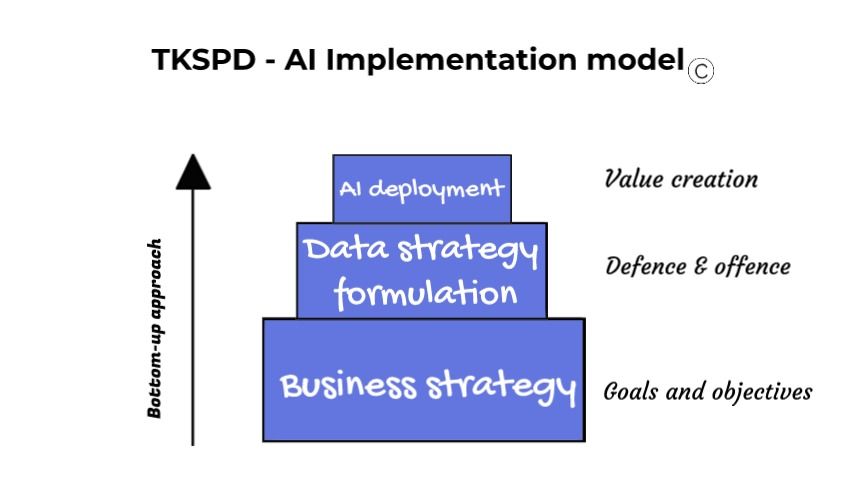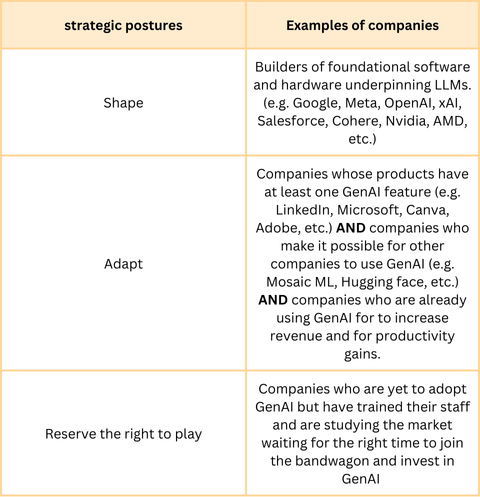Today, artificial intelligence (especially generative AI) has been propelled to the forefront of business news and has even become highly topical amongst the C-suite executives.
Why? It is because AI is touted to be the next "big thing” and has been ranked amongst other disruptive and ground-breaking inventions such as electricity and the internet.
Why? It is because AI is touted to be the next "big thing” and has been ranked amongst other disruptive and ground-breaking inventions such as electricity and the internet.
Because of its perceived disruptive nature, investments in AI have increased dramatically. Research by Goldman Sachs forecasts that by 2025, AI investments will reach a whopping $100 Billion in the US alone, and $200 Billion worldwide.
While AI will likely transform the workplace, there are concerns that it will replace jobs, and governments are still struggling to provide a regulatory framework that will achieve a balance between fostering innovation and societal and environmental protection.
There are already reports from the C-suite complaining that they are yet to realize adequate ROI from their investments.
This isn’t surprising. Many companies slap AI into everything they do without doing the hard work of confronting foundational issues regarding poor data quality, lack of organizational alignment, and the lack of a skilled workforce.
This isn’t surprising. Many companies slap AI into everything they do without doing the hard work of confronting foundational issues regarding poor data quality, lack of organizational alignment, and the lack of a skilled workforce.
This article will show how companies can craft winning data and AI strategies.
What’s presently being done??
The c-suite is in panic mode. Everyone wants to join the AI bandwagon. Remember, the word out there is that if you don’t innovate, you will be left behind.
A survey conducted by McKinsey in May 2024 came up with an interesting fact: 65% of respondents confirmed that their company is regularly using Gen AI.
While adoption is high, many companies are yet to benefit from the new technology as touted and promised by the vendors in the space.
A survey conducted by McKinsey in May 2024 came up with an interesting fact: 65% of respondents confirmed that their company is regularly using Gen AI.
While adoption is high, many companies are yet to benefit from the new technology as touted and promised by the vendors in the space.
Why is this happening?
The answer is easy: many companies do not have a strategy on how (and where) to use Gen AI. Also, companies have failed to tackle the fundamental issues concerning data quality, level of business literacy amongst their data teams, and lack of strategic data leadership.
The answer is easy: many companies do not have a strategy on how (and where) to use Gen AI. Also, companies have failed to tackle the fundamental issues concerning data quality, level of business literacy amongst their data teams, and lack of strategic data leadership.
When your data quality is bad, the quality of the outputs coming from your LLM applications will be faulty. Who wants to waste a lot of money and time building a LLM application then have it churn out incorrect results? I’m sure the disastrous unveiling of Bard (Google’s LLM) will be a cautionary note for everyone.
Also, when business stakeholders are not made aware of the capabilities of new data technologies, they will be unable to leverage the transformative power of data and AI.
Data experts (especially the leaders) who should be the ones to inform their business counterparts can’t speak the language of business stakeholders.
Hence, communication is inadequate, and collaboration is limited.
Data experts (especially the leaders) who should be the ones to inform their business counterparts can’t speak the language of business stakeholders.
Hence, communication is inadequate, and collaboration is limited.
Under these scenarios, companies will struggle to leverage their proprietary data to unlock the productivity gains as promised by Gen AI vendors.
What’s the best way to go about it?
At TKSPD, we recently created a winning framework to guide companies as they embark on AI implementation. We strongly believe that before a company can deploy AI tools for its customers, partners, or employees, all departments must be aligned behind the strategy of the organization.
Any strategy created by any functional unit of an organization (department) must be done to support the overarching business strategy of the organization. Departments perform initiatives (often called tactics) to help the business achieve its goals and to realize its vision.
Hence, data strategies (either offense or defense) can’t be successful if they are not created in line with business aspirations. And if the data strategy is not robust enough, then AI (especially Gen AI) deployment will end in wastage and ultimately, failure.
Companies should begin with a picture of a desired goal. A vision of where it sees itself in the future. For example, a sustainable shoe retailer might want to be the “number one sustainable shoe brand in North America by 2034”.
To achieve this lofty goal, the leaders then take a decision to ignore certain activities and choose specific activities to get their prospective and current customers to perform a desired action (i.e. buy more quantity of shoes and tell their friends and family to buy more quantity of shoes).
To achieve this lofty goal, the leaders then take a decision to ignore certain activities and choose specific activities to get their prospective and current customers to perform a desired action (i.e. buy more quantity of shoes and tell their friends and family to buy more quantity of shoes).
The choice to undertake certain or specific activities (e.g. fast delivery, excellent customer service, easy returns, investment in high quality design and manufacturing of their sustainable shoe, outsourcing of manufacturing, etc.) and ignore others reflects the strategy of the firm.
These chosen set of activities (strategy) must be communicated extensively across all departments to gain alignment. This is to ensure that all departments are working in tandem to realize the vision and business goals.

A data team that is well versed in the strategy of their organization is equally aware of the activities it must prioritize. Hence, they start thinking of what data strategy they must create to help the business achieve its goals.
As in the sustainable shoe manufacturer, the data team may focus its strategy on getting high quality data to support the business to reduce churn, to increase time spent by customers on the website/app, to segment the customers for improved targeting, and to provide personalized marketing campaigns.
As in the sustainable shoe manufacturer, the data team may focus its strategy on getting high quality data to support the business to reduce churn, to increase time spent by customers on the website/app, to segment the customers for improved targeting, and to provide personalized marketing campaigns.
When these actions are performed by the data team, the business will realize increased revenues and its market share will increase- helping it move forward to achieve its vision to be the number one seller of sustainable shoe retailer in North America.
Data strategies have two dimensions: offense and defense. They are two sides of the same coin.
Defensive strategies are geared towards making sure that clean, secure, and high-quality data gets to the right person, at the right time, and in the right format. They also ensure that data is acquired and kept in accordance with relevant laws and regulations and prevented from getting into the wrong hands.
Listed under this type of strategy are data privacy, data quality, data governance, Fraud & theft prevention, and compliance.
These defensive activities are prioritized particularly in the healthcare and banking sectors.
Listed under this type of strategy are data privacy, data quality, data governance, Fraud & theft prevention, and compliance.
These defensive activities are prioritized particularly in the healthcare and banking sectors.
Offensive strategies are geared towards making sure management take data-driven decisions to reduce costs and improve profits. Analytics can be descriptive, diagnostic, predictive, and prescriptive.
Data analysts, scientists, and engineers use statistical approaches, tools, and other data technologies (e.g. AI & ML) to crunch, curate, and visualize data and generate crucial insights to help their business stakeholders take important business decisions.
Data analysts, scientists, and engineers use statistical approaches, tools, and other data technologies (e.g. AI & ML) to crunch, curate, and visualize data and generate crucial insights to help their business stakeholders take important business decisions.
A good data quality will help generate good insights, a bad quality data will not. Data theft or accidental leakage can wreck the reputation of a firm, and it can lead to customer churn. Data gotten from customers in an unethical manner can lead to lawsuits and fines. So, both defensive and offensive strategies feed into each other.
Hence, the sustainable shoe retailer can benefit from having an offensive strategy that allows it to improve the sales of its shoes by better satisfying its customers. Defensive strategies can allow it to prevent cyber threats, to comply with data regulations (GDPR, CPRA, HIPAA, and others), and to have access to clean data.
Only when the data strategy and of a firm is up and running can it start thinking of reaping the dividends of its investments in Gen AI. Though there are many uncertainties around the technology, a company can either "shape", "adapt" or “reserve the right to play” in the GenAI space.
The shapers of this new space are those building LLMs (OpenAI, Cohere, Amazon, Meta, Salesforce) and those manufacturing the hardware to train the models (Nvidia, AMD, Intel). It’s a huge undertaking.
The adapters are those companies who have either deployed the LLMs built by the shapers in their own products or those who have built new products and apps based on foundational LLMs, or those who make it easy for companies to use foundational LLM or build their own LLMs (e.g. Mosaic ML, Domino, and open-source model hubs).
Adapters require medium-level investment. You only need to pay to use a foundational LLM (through APIs or through open sources) and train them either in your own server, on cloud providers (Amazon, Microsoft, Google, Salesforce) or even hybrid (RedHat).
The adapters are those companies who have either deployed the LLMs built by the shapers in their own products or those who have built new products and apps based on foundational LLMs, or those who make it easy for companies to use foundational LLM or build their own LLMs (e.g. Mosaic ML, Domino, and open-source model hubs).
Adapters require medium-level investment. You only need to pay to use a foundational LLM (through APIs or through open sources) and train them either in your own server, on cloud providers (Amazon, Microsoft, Google, Salesforce) or even hybrid (RedHat).

Those who “reserve a right to play” are companies skeptical about LLMs but have moved on to the pilot phases- looking for where and how it will be of value. And those who have not yet adopted LLMs but have trained their staff on the use of GenAI and are waiting for the right circumstance to jump on the so-called bandwagon.
Companies looking to deploy GenAI will benefit immensely from a having robust data strategy. When their proprietary data is in good condition, it can then be used to fine-tune LLMs or to build their own LLM or SLM (if the company has the resources).
To deploy GenAI, data leaders are to look at the areas where quick wins can be made. When pilots are successfully carried out, it can then be extended across the organization.
Back to the sustainable shoe retailer, the data team (in partnership with business stakeholders in sales and marketing) can deploy GenAI to generate marketing briefs, create multimodal content, generate email campaigns, and to summarize training materials for new sales recruits.
The reduction in the time it takes to create marketing materials and to train new recruits are productivity gains, freeing up more time for more strategic and value-adding initiatives.
Back to the sustainable shoe retailer, the data team (in partnership with business stakeholders in sales and marketing) can deploy GenAI to generate marketing briefs, create multimodal content, generate email campaigns, and to summarize training materials for new sales recruits.
The reduction in the time it takes to create marketing materials and to train new recruits are productivity gains, freeing up more time for more strategic and value-adding initiatives.
Lessons for business/data leaders
Business leaders must ensure that AI strategies are not built in a vacuum. Strategies regarding AI must be built on top of a robust and well-articulated business and data strategies.
Companies are likely to achieve a higher success on AI deployment if all employees know the goals of the business, if they have a secure and high-quality data, and they find areas where GenAI will make the most impact to contribute to business goals.
Companies are likely to achieve a higher success on AI deployment if all employees know the goals of the business, if they have a secure and high-quality data, and they find areas where GenAI will make the most impact to contribute to business goals.
To generate any noticeable value from GenAI, it must not be seen as a silver bullet. Fundamental challenges must be resolved before AI is deployed. Data teams must be made aware of the business strategy and the crucial goals the firm is trying to achieve.
For this to be done easily, they must have a good understanding of management basics. Shorts courses in finance, marketing, strategy, business communication and leadership can allow them to be aware of business lingos and terminologies- fostering increased collaboration with business stakeholders. SchoolofMBA is a micro-learning platform that can be beneficial in this regard. Our 4hr Business Mastery course is a must-have for any data leader looking to upskill their team with business and financial literacy.
For this to be done easily, they must have a good understanding of management basics. Shorts courses in finance, marketing, strategy, business communication and leadership can allow them to be aware of business lingos and terminologies- fostering increased collaboration with business stakeholders. SchoolofMBA is a micro-learning platform that can be beneficial in this regard. Our 4hr Business Mastery course is a must-have for any data leader looking to upskill their team with business and financial literacy.
Also, leaders must formulate a good data strategy to increase the effectiveness of their data initiatives.
A good data strategy will benefit an organization by ensuring that secure and a high-quality data is available to the right person, at the right time, and in the right format. Our Business, data, & AI strategy course is perfect for data leaders and professionals looking to acquire the crucial knowledge to align data & AI initiatives with business goals and to provide strategic leadership to the data team. It takes just 100mins to complete.
A good data strategy will benefit an organization by ensuring that secure and a high-quality data is available to the right person, at the right time, and in the right format. Our Business, data, & AI strategy course is perfect for data leaders and professionals looking to acquire the crucial knowledge to align data & AI initiatives with business goals and to provide strategic leadership to the data team. It takes just 100mins to complete.
Finally, the nature and adoption of Gen AI is still mired in uncertainties. Depending on their unique circumstances, companies must take actions to either shape, adapt to, to reserve the right to play in the GenAI space.
If GenAI deployment is not reducing costs or improving profits/revenues, then the company must step back and have a rethink on ways to reap the transformative value of GenAI.
If GenAI deployment is not reducing costs or improving profits/revenues, then the company must step back and have a rethink on ways to reap the transformative value of GenAI.
Conclusion
We will continue to hear stories and news about GenAI. The hype is still out there. There is a lot of money involved. Nobody wants to lose out on it. But the business leaders who intend to reap its transformative value must make bold and conscious decisions.
Everything in business is fraught with risks, so leaders must be aware of these risks and create strategies to mitigate them.
Everything in business is fraught with risks, so leaders must be aware of these risks and create strategies to mitigate them.
Once again, GenAI deployment won’t work if it is done in a vacuum.
At TKSPD, we believe it must be a bottom-up process- starting with the creation and the extensive articulation of the business strategy and data strategies. Leaders must upskill their data teams with business literacy to increase collaboration with business stakeholders.
At TKSPD, we believe it must be a bottom-up process- starting with the creation and the extensive articulation of the business strategy and data strategies. Leaders must upskill their data teams with business literacy to increase collaboration with business stakeholders.
To end, piloting the use of GenAI in certain areas of the organization (e.g. sales & marketing) and learning from it is a "win" on its own. So, start experimenting today and make sure you learn from your wins/failures!
Reach out to the authors here:
Kehinde@schoolofmba.com
taiwo@schoolofmba.com


